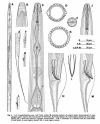
Campbellenchus poae (from Wouts, 1977)
|
Refer to subfamily diagnosis (Tylodorinae).
- Amphids with small to medium-sized, radial, slit-shaped
opening
- Stylet more than 20 um long, slender.
- Vulva slightly posterior to mid body.
- Prodelphic ovary usually with double reflex, distal end
occasionally reaching esophageal region.
- Lateral field obscured by longitudinal striae.
- Cuticle with pronounced annulation behind lip region;
tesselate where they meet longitudinal striae.
- Deirid distinct.
- Tail filiform gradually tapering to about 2 anal body widths
posterior to anus, then long and filiform more posterior..
|